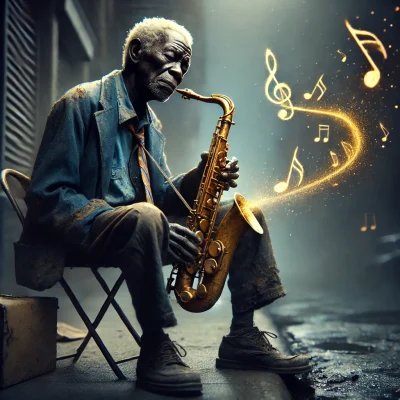SSLC English Question and Answer: Jazz Poem Two
Looking for SSLC English Studies textbook answers? You can download Chapter 5: Jazz Poem Two Questions and Answers PDF, Notes, and Summary here. SSLC English 2nd Language solutions follow the Karnataka State Board Syllabus, making it easier for students to revise and score higher in exams.
Karnataka SSLC 2nd Language English Textbook Answers—Reflections Poem 5
Jazz Poem Two Questions and Answers, Notes, and Summary
Class 10 2nd language English Poem Chapter 5
Jazz Poem Two
Scroll Down to Download Jazz Poem Two PDF
Comprehension I: Jazz Poem Two
Question 1.
Read the first stanza and fill in the table.
Answer:
Feature | Description of the poem |
Face | Wrinkled, full of the wearies of living |
Eyes | Closed |
Shirt | Faded-blue, frayed-collar, dark with sweat |
Necktie | Undone, drops loosely |
Jacket | Worn, barely holding his sagging stomach in |
Shoes | Run-down, have paper in them |
Question 2.
Why do you think the Jazz player keeps his head down?
Answer:
The Jazz player keeps his head down because he is weary from life, burdened by struggles and solitude. His posture reflects his exhaustion and the hardships he has endured.
Question 3.
The word ‘old’ has been repeated several times in the first two stanzas. What does this suggest?
Answer:
The repetition of old emphasizes the Jazz player’s worn-out state, both physically and emotionally. It highlights his struggles, poverty, and life’s toll on him.
Question 4.
What description do lines 13 to 18 suggest about the Jazz player?
Answer:
These lines describe his loneliness and deep concentration. Despite his hardships, he is absorbed in the music, listening intently to the bass line, as if it is his only connection to the world.
Question 5.
a) Is there any change in the stature of the Jazz player in lines 19 to 25?
Answer:
Yes, there is a transformation. As he begins to play his saxophone, he rises above his struggles. His posture changes from being tired and weary to that of a performer deeply connected to his art.
b) Now read the lines from 31 to 35. Can you guess what he is meditating on?
Answer:
He is meditating on his identity and purpose. Through his music, he expresses his heritage, struggles, and the deep emotions of being a Black man. His saxophone becomes his voice, preaching the Black Gospel of Jazz.
Question 6.
How has he held his instrument?
Answer:
He supports his saxophone using a wire coat hanger around his neck and lifts it gently to his lips as he prepares to play.
Question 7.
Read the lines from 29 to 41. Can you imagine that picture?
Answer:
Yes, these lines create a vivid image of the jazz player immersed in his music. His body transforms as he plays—he is no longer just a man but a Bird flying high with the power of his music. His notes soar, lifting him beyond his struggles and creating a moment of freedom and transcendence.
Question 8.
‘Preaching it with words’ (line 35). What does ‘it’ stand for here?
Answer:
‘It’ refers to jazz music, which he uses as a form of expression, storytelling, and emotional release. His music is his sermon, spreading the message of the Black experience.
Question 9.
‘He is no longer a man,’ says the poet (line 37). Who else is he supposed to be if he is no longer a man?
Answer:
He becomes a Bird, a metaphor for freedom, transcendence, and artistic elevation. He is spiritually uplifted, escaping the burdens of his earthly life through his music.
Question 10.
Read the last ten words of the poem. You may observe a change in the tone. What is that about?
Answer:
The tone shifts from transcendence to reality. After soaring high with his music, he comes back to find himself a Black man again. This return signifies the harsh reality that, despite his musical escape, he must face his identity and struggles in the real world.
Comprehension II: Jazz Poem Two
Question 1.
Usually, a poem is written in a stanza form with a rhyme scheme. Check and find out whether this poem follows any rhyme scheme. You may compare this poem with the poem “Seal” given below.
Answer:
No, Jazz Poem Two does not follow a conventional rhyme scheme. Unlike traditional poetry with structured stanzas and rhyming patterns, this poem is written in free verse. It mimics the spontaneous and improvisational nature of jazz music, allowing the rhythm and flow to resemble a jazz performance rather than a structured poem.
Question 2.
Refer to the last stanza of ‘Jazz Poem Two.’. Do you find anything extraordinary in the shape of the poem? Check the length of each line carefully. Why do you think lines 41, 42, and 43 are different from others? What does it suggest?
Answer:
The shape of the last stanza
The last three lines (41, 42, and 43) are visually different from the rest of the poem. They gradually increase in spacing:
- flies high
- high higher
- higher until he flies away!
This unique structure suggests the rising movement of the jazz player as he plays, symbolizing his transcendence and spiritual elevation through music. It visually represents the flight of the “Bird,” showing how he is lifted by his music before eventually “flying away.”
Question 3.
The poem is full of images. Identify more examples.
Here are some powerful word pictures (images) found in the poem:
Answer:
a) Wrinkled old face—Shows the weariness and struggles of the jazz player.
b) Sagging stomach—Indicates poverty and physical exhaustion.
c) Run-down shoes with paper in them—Suggest his financial struggles and hardship.
d) Alto saxophone supported from his neck by a wire coat hanger—Represents his resourcefulness and dedication despite his struggles.
e) Preaching it with words of screaming notes & chords—Creates an image of passionate, expressive jazz music.
Question 4:
Is there a simile in the poem? If so, identify it.
Answer:
Yes, there is a simile in the first line:
“There he stands, see? like a black Ancient Mariner”
This compares the jazz player to the Ancient Mariner, a character from Samuel Taylor Coleridge’s poem The Rime of the Ancient Mariner. Like the mariner, the jazz player appears old, weary, and burdened by life’s struggles.
Jazz Poem Two Summary
Carl Wendall Hines Jr. wrote both Jazz Poem One and Jazz Poem Two. The first poem describes a jazz musician standing at the peak of a hill, playing his trumpet, yet feeling unseen and unheard. His music, though powerful, seems to exist in isolation, waiting for someone to truly listen and connect with it.
In Jazz Poem Two, the poet presents the image of an old jazz musician, drawing a comparison to the Ancient Mariner from Coleridge’s poem. Like the Mariner, the jazz player appears weary, detached from the world, yet possesses a commanding presence. Though silent in speech, he expresses himself eloquently through music, his gift allowing him to move people through his art.
The poem paints a vivid picture of the musician’s appearance. He is old, with a wrinkled face that reflects the hardships of his life. His head is bowed, and his eyes remain closed. He wears a faded blue shirt, damp with sweat, and a torn tie. His old jacket barely holds his sagging stomach, and his worn-out shoes have paper stuffed inside them. His unshaven face carries deep lines of pain.
Standing alone in solitude, he listens intently to the rhythm of the bass line. Around his neck hangs an old alto saxophone, suspended by a wire coat hanger. He plays not just for himself but to proclaim his identity—to tell the world that he is a Black Man, a preacher of the Black Gospel of Jazz. Through his music, he speaks with loud, soulful notes, expressing the struggles and spirit of his people.
As he plays, a transformation takes place—he is no longer just a man, but a Bird. His music lifts him higher and higher, carrying him into a state of transcendence. Yet, when the music ends, he returns to reality, once again finding himself as a Black Man, bound by the same struggles he momentarily escaped.
The poem beautifully captures the power of jazz as a form of expression, showing how music can serve as both an escape and a declaration of identity.

